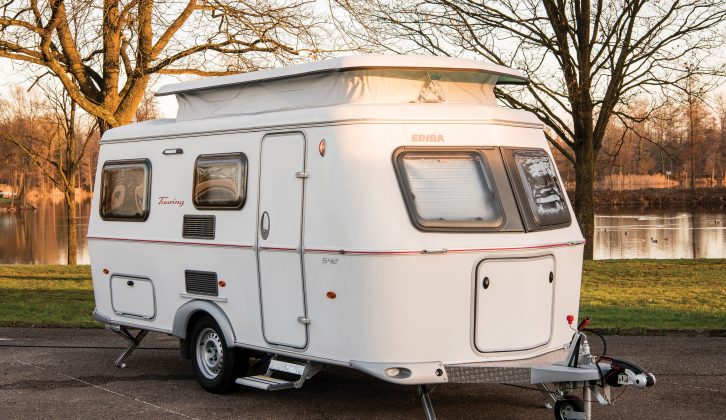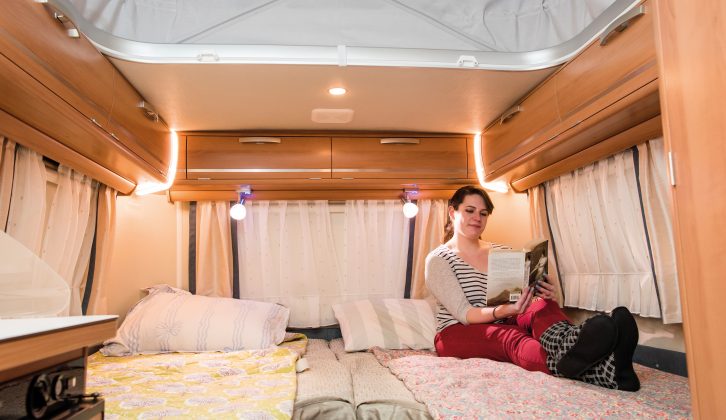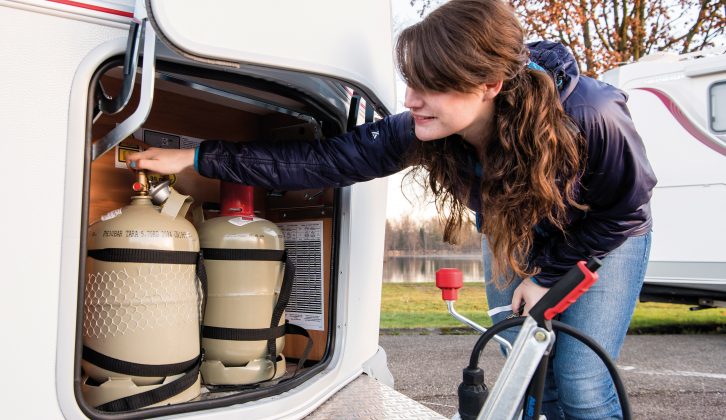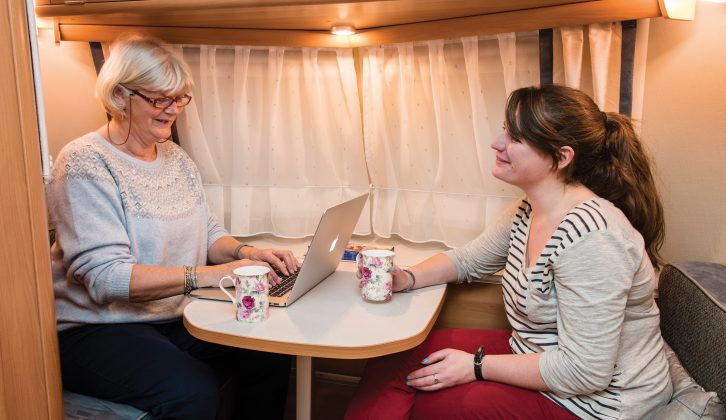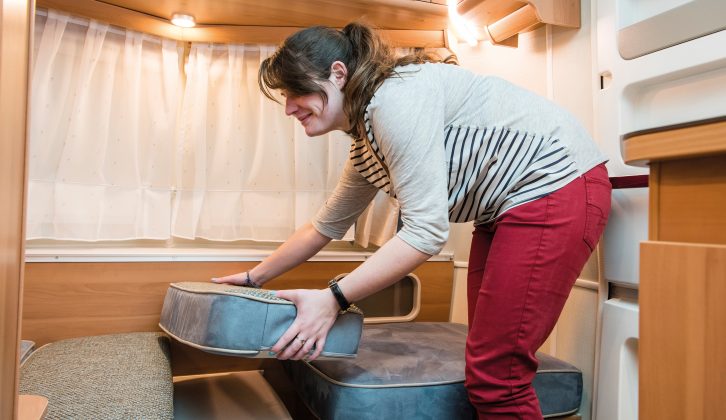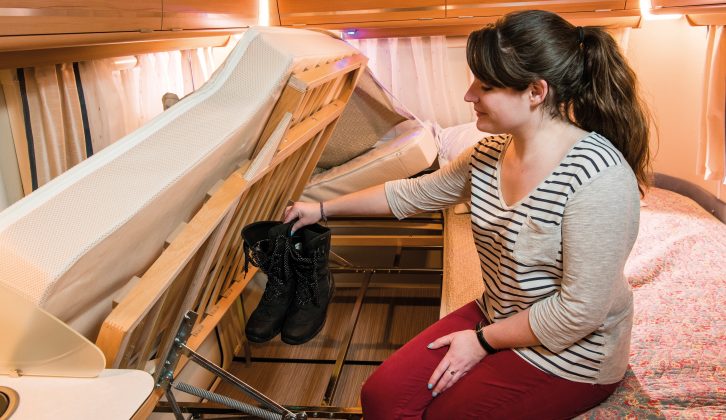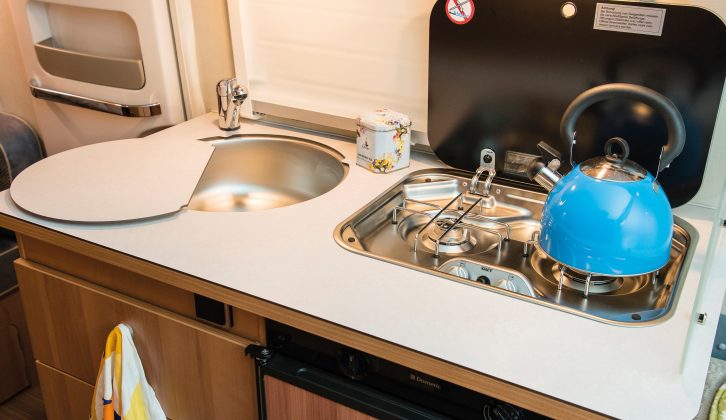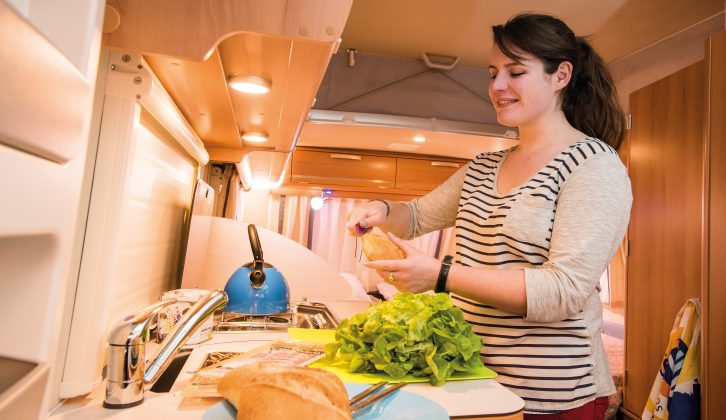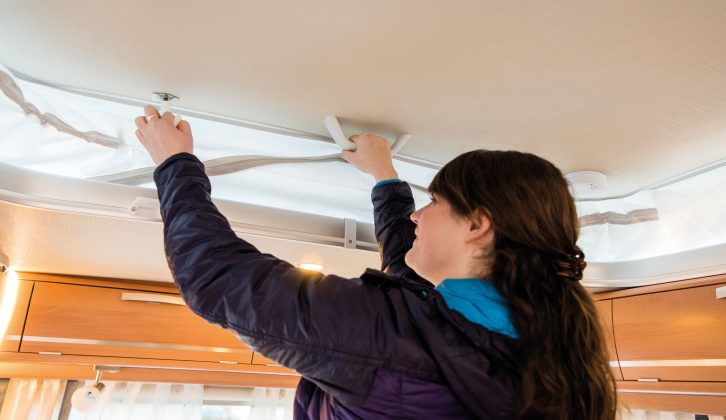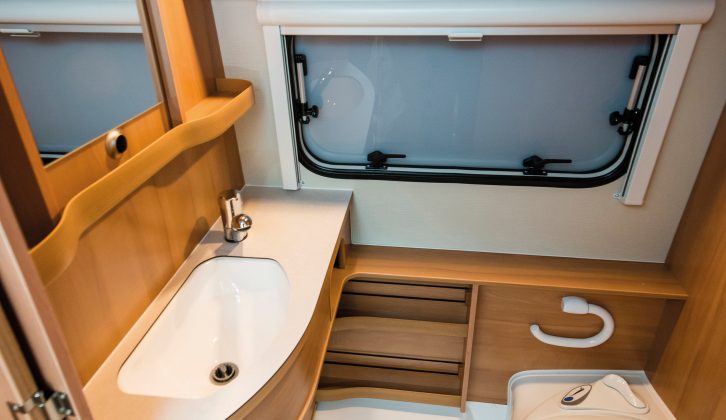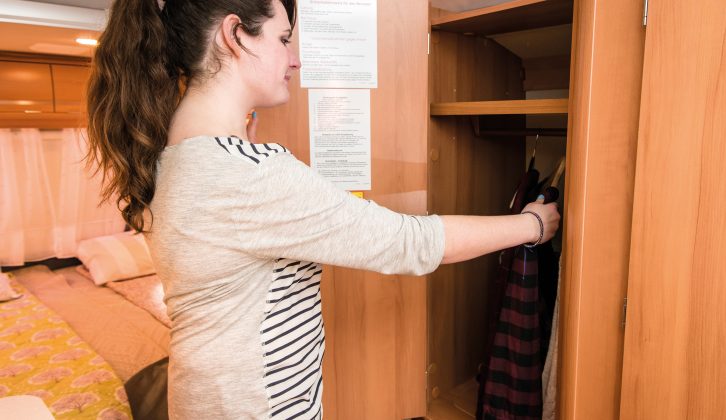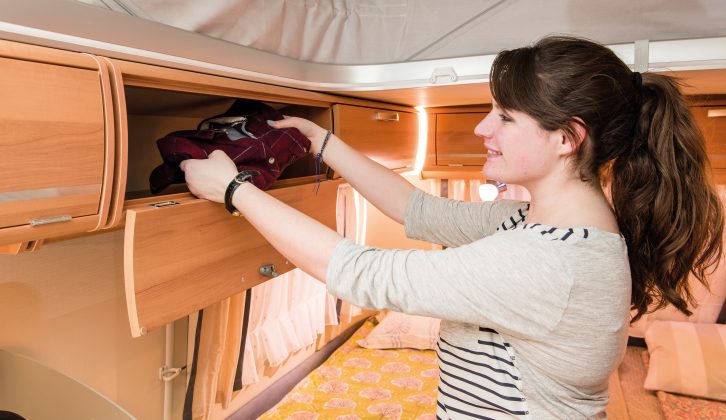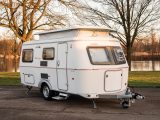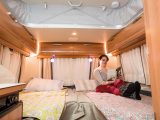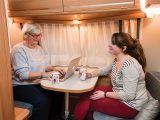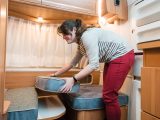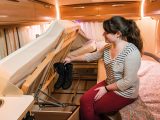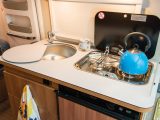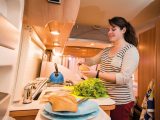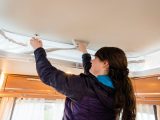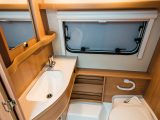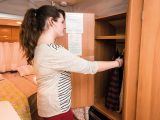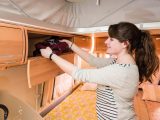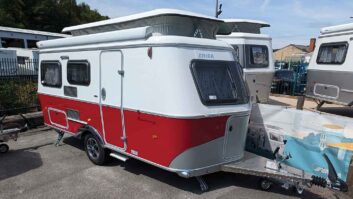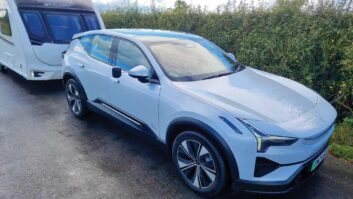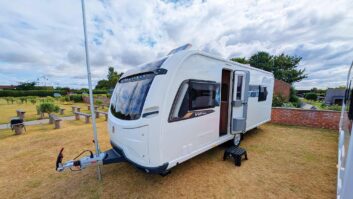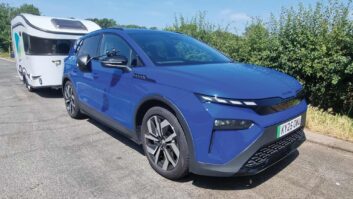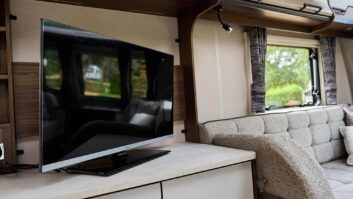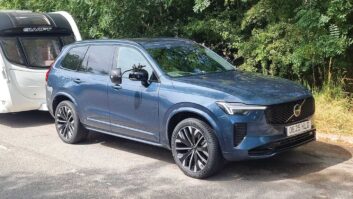Verdict
If you’re 6ft 2in or over, the Eriba Touring Troll 542 may not be the tourer for you: your shoulders will catch on the upper limits of the rigid body and there is not enough room to shower if you go for that option. Likewise, if you enjoy lounging while watching the telly during caravan holidays, forget about it here.
However, if you like to be on the move, especially on the Continent where the weather is a little kinder, and you love the outdoor life, then this beautifully engineered German gem may appeal to you.
There could be more lighting over the dinette, and another access locker on the nearside. But price may be the biggest stumbling block: once a few choice options have been added, most Eriba Troll caravans sold in the UK cost up to an eye-watering £20k.
Otherwise, there’s little to quibble with, and there’s that huge 360kg payload to play with. You’ll also have no height fears on ferry crossings and the Eriba Touring Troll 542 will fit in your garage with ease. Plenty of tow cars will be capable of towing the Eriba – for the recommended 85% match, you’ll need a tow car with a kerbweight of 1529kg or more.
Pros
Very lightweight
Stable on the road
Good payload
Fits in a garage at home
Steel bar to help you close the door quickly from inside
Entrance step that pulls out
Cons
No good for tall people
No lounge
No oven
Just two burners
Expensive
Needs more light over the dinette
Needs a second access door for the under-bed storage
With more than half a century under its belt, the instantly recognisable Eriba caravan brand has been declared an ‘icon’. Like the equally iconic Airstream from America, the design of this German stalwart has changed very little since its launch in the late 1950s.
The US brand may have 30 years on the Eriba, but the ethos of Airstream’s inventor, Wally Byam, can be applied to its European counterpart: “Let’s not make changes, let’s only make improvements.”
The Eriba Troll is Hymer’s original caravan and is the result of a collaboration in 1957 between Erwin Hymer and aircraft engineer Erich Bachem, who gave his name to the brand.
There are now five models under the Eriba brand, with the Touring Troll being the largest. The basic structure of a tubular steel skeleton, good insulation and an aluminium body remains pretty much unchanged since those original vans. The furniture is bolted to the frame so there is no movement and, therefore, very little stress leading to cracks and leakage.
We tested a Continental-spec Eriba Touring Troll 542 in Germany and in some fairly wintry conditions, encountering high winds, rain and snow when towing and low temperatures on the pitch.
When it comes to design, the Troll’s curved, aerodynamic shape has remained more or less unchanged since its inception 55 years ago. The box-section frame supports two-sectioned aluminium panels for its front, rear and sidewalls; the top, which houses the pop-up roof, is in GRP. The awning rail wraps around the entire van – great for canopy-style awnings to shield you from the sun – and the long, steel single grab-bar at the rear, covering the full width, makes perfect sense. It may be fanciful but in some ways the caravan’s V-shaped nose resembles that of an aircraft. Or is it that the bay windows look like a pair of early airman’s goggles? Whichever it is, the shape allows interesting storage detailing inside.
The finish is excellent, with medium-tone wood and neutral oatmeal furnishings on UK vans. (Our German test van featured a bold blue finish.) But it’s the attention to detail that is so impressive: the gas locker, for example, is wood-lined, and its lid lifts on struts with a parallelogram hinge. And why don’t all caravans have an entrance step that can be pulled out? The answer, of course, is weight. The Eriba Touring Troll 542’s MiRO is only 940kg and it’s not weighed down by the kitchen kit and caboodle that the majority of British tourers carry around.
The caravan has its entrance door and services on the wrong side for the UK – which is fine if you do most of your touring on the Continent – and it’s light enough to swing around on a pitch. Its knobbly white body surface won’t appeal to everyone, but you can always opt for the Eriba Touring GT Troll package, which gives it a smooth, two-toned silver body and extra kudos from fans of this look – you can’t help but admire it.
So, what is it like to tow this Eriba Touring Troll 542? You might think that the Troll’s compact size and low weight – when empty – would make towing it tricky, because smaller caravans can feel unstable in a crosswind. However, the Eriba has an aerodynamic shape and rides an Al-Ko chassis with an extra-long towbar; that, along with the Al-Ko AKS hitch stabiliser, automatic brake adjuster and low centre of gravity, make it an easy tow.
The Troll feels stable and secure, even in high winds on the autobahn; when being passed by lorries, it towed straight and smooth. As well as the slippery shape, the lower roofline with the pop-top stowed is definitely a help. And to see other Eriba caravans for sale, click here.
The Troll feels stable and secure, even in high winds on the autobahn; when being passed by lorries, it towed straight and smooth
Pitching & Setting-up
Getting this well-behaved van onto a pitch is comparatively easy; its compact shape allows plenty of visibility and manoeuvring room. Even if your pitching skills aren’t up to much, the stainless-steel grabhandles at the front, and that long bar at the back, make it easy to haul the 1300kg MTPLM van into place.
The steadies couldn’t be easier to access; there’s no getting down on your knees to find the winding bolts.
The neat gas locker will house two bottles but little else, which is good for the noseweight, and the cantilever action of the door gets it out of the way when it’s time to change the bottles. The services – the water inlet, electric hook-up point and toilet cassette hatch – are on the UK nearside, but there’s no exterior access to the battery box, which is under the foot end of the offside bed.
On the offside exterior is a locker to the vast space under the twin beds, but that area covers the width of the van so it could do with access on the nearside as well.
A nice touch is the slot above the offside wheel, which allows you to hook on the table for al fresco dining and imbibing – in January it was a joy we could only imagine.
The awning light is located away from the door, between the kitchen and bedroom windows, so that your shadow will not obscure the step as you leave the van in the dark. There are two switches that operate the awning light: one leaves it on; the second is movement sensitive, so it will come on as you approach the van or open the door to leave it.
Mains light switches are just inside the one-piece entrance door; there are no controls for the heating here because the Truma blown-air heater is gas only. Aboard our test van was the optional 30-litre fresh-water tank so there was no need for an Aquaroll, and there’s a single waste-water outlet. The GT options pack also includes a water heater, which is turned on via a rocker switch, and a 40-litre waste-water tank.
Those taller than 5ft 9in will need to pop up the roof, which is secured by four levers, two at either end. Raise the top by pulling the levers down and out and then pushing up the roof, then you get an interior ceiling height of 1.95m.
To close the pop-top roof, use the handles to pull the roof down, making sure the canvas is tucked inside, then pop the levers back. The roof has zipped ventilation windows for those roaring hot days and fly screens to keep out insects.
Another ‘why-don’t-all-vans-have-this’ feature is the full-width steel bar across the inside of the entrance door; it is easy to grab and pull quickly to keep the heat in. The door also has two built-in shelves for keys, or they could be used as spice racks because it is adjacent to the kitchen. The bottom of the door has elastics for magazines, but choose the GT option and you get a good-size waste bin, which is divided in two to help you with your recycling.
Living
With the rear of the van taken up by the fixed beds, the only living space you get is a single dinette at the front. With attractive Merano pear wood furniture finish and Hymer’s stain-guard fabrics, it’s a practical dinette. There’s ample room for two people and you could also squeeze in a little one. There are two coat hooks on a suede-effect panel in this area, two thin vertical corner lights and a touch-sensitive spotlight.
You get a wide shelf that follows the V-shape of the bay window and a power point for charging phones, iPods and other devices. The two double- glazed windows have flyscreens, blinds, net curtains and heavier curtains, so you have plenty of choice on how much privacy you want to give yourself.
The two long roof lockers are quite deep because they follow the contours of the van’s nose. In addition, a much smaller locker is provided to stow keys, specs and so on – those things that somehow always get swallowed up by the ‘black hole’ clutter in a van. There are two great cubbyholes, one on either side of the table, that follow the contour of the nose, giving you space to stow magazines and books. A shallow cubby at the bottom of the washroom bulkhead faces you as you enter the van. The area is kept warm by a Truma gas-only blown-air space heater that sits beneath the wardrobe.
Kitchen
The nearside kitchen has a stainless-steel sink with domestic-style chrome-plated tap and a laminated cover. A two-burner gas hob with a glass lid is set into the worktop. You do have the cost option of a three-burner hob, but that’s all you get on the cooking front because, of course, you’ll be outside cooking on a barbecue!
A safety-glass screen prevents pans from being knocked accidentally onto the adjacent beds, and the hob is set back so your panhandles can safely be turned towards the front.
The workspace isn’t vast but a small extension flap helps the cause. Two touch-sensitive spots illuminate the area by night and a window with flyscreen and blind does the job by day.
Just beneath the worktop is a mains socket and below that a good-sized cutlery drawer, which also holds the gas controls. Beneath that is a large cupboard and a 70-litre fridge. Above it all are two overhead lockers.
Washroom
The washroom is small but it’s very well thought-through. On the inside of the domestic-style door are two long towel rails. The shower tray forms the washroom floor, although the shower equipment is a cost option, and there is a Thetford electric-flush bench toilet with cassette. A small washbasin sits within a hard, laminate surround and is served by a chrome-plated tap; the GT option adds a showerhead. Hot water is delivered by a Truma Therme water heater.
There is shelving above the window, basin, wheelarch and the toilet. A mirror is attached to the pop-up roof with a strap, so it slides up when the roof is raised to reveal a shallow space behind, perhaps for electric toothbrushes.
A cupboard below the basin has positive catches and brushed metal handles; this is where the shower hose is stored should you choose that option. There’s a frosted opening window and two touch-sensitive lights.
It’s not very private, however, though a canvas flap can be unrolled from the roof to fill the space above the door.
Beds
The Eriba Touring Troll 542 is marketed as having fixed twin beds, which are joined at one end, but you can buy an infill to make it into a double. As singles, they are a generous size, as a double it offers acres of space.
The front single beds are 1.98m x 0.73m each and the rear bed area is 1.90m to 1.97m x 1.98m. Each mattress is split, so the frame can be raised on gas struts to access the space below. The cold-foam mattresses are thick and comfortable and the beach-slatted frames have a fabric handle for pulling them down.
The side dinette is easily converted into a single bed for a child: lower the table to use it as a base between the seats then rearrange the cushions.
Six overhead lockers and four swivel spotlights serve the bed area, plus a pocket is fitted at the foot of each. There’s no shelf to put a cuppa, though, and the rear window will make sitting up in bed uncomfortable unless you tuck yourself into a corner.
Storage
This is where the ingenuity of the designers really comes to the fore. By linking the two fixed singles and having that inset in the base to give access, the designer has created a vast space below that will easily take lounging chairs and other bulky paraphernalia. Having said that, an awning would be best transported inside the van, over the wheels.
The bases of the dinette seats have stowage space, but in our test van an optional 30-litre water tank occupied that on the offside. There are 10 good-sized roof lockers to take a couple’s belongings and groceries, plus that large cupboard just below the cutlery drawer.
The ample wardrobe has half-length hanging space and a shelf above it. The top of the wardrobe has a lip around it, so you can use it for extra storage. A second mains socket is flat on top, so you could use it for a kettle or a hairdryer.
Again, though, there’s delight in the little nooks and crannies the designers have so artfully employed. The access to the space in the nose is open, which makes more sense than trying to put on a door, and we like the cubbies in the entrance door and the wall outside the washroom.
Technical Specifications
| Berth | 3 |
| MiRO | 940 kg |
| Payload | 360 kg |
| MTPLM | 1300 kg |
| Shipping Length | 4.71 m |
| Width | 2.1 m |
